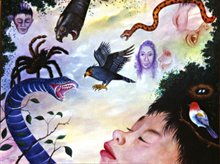Altered States: The Origin of Art in Entoptic Phenomena
J.D. Lewis-Williams and T.A. Dowson (1988) in their article 'The Signs of All Times' propose a neurobridge backwards in time to the Upper Palaeolithic by which we can gain insight into the nature of the origins of art.
Our nervous system has not changed much in the past 100,000 years.
We are still physically very much the hunter-gatherers we were prior to agrarianism.
In the signs of Upper Palaeolithic art Lewis-Williams and Dowson see entoptic phenomena very similar to those produced by people in altered states of consciousness today. '
Entoptic' is derived from the Greek for 'within vision', that is, anywhere within the optic system between and including the eye itself and the cortex where signals from the optic nerve are interpreted (Lewis-Williams and Dowson, 1988).
Lewis-Williams and Dowson further break these down into 'phosphenes' which can be produced by physical stimulation (such as the patterns seen when you close your eyes and apply gentle pressure to your eyelids), and 'form constants' which are produced beyond the eye in the cortex itself. It is the latter which Lewis-Williams and Dowson (1988) primarily focus on, though they do not exclude phosphenes, and refer to both under the general term 'entoptics'.
They do, however, distinguish between entoptics and hallucinations.
Entoptics are geometric patterns whose origins are in the nervous system itself, whereas hallucinations are iconic and culturally determined and may be experienced in all senses (aural, visual, tactile, olfactory and synesthetic) not just the visual. Hallucinations may arise out of entoptics as will be outlined shortly.
συνεχεια:
The six entoptic forms:
Κακόβουλη βλασφημία: ΕΩΣ ΔΥΟ ΧΡΟΝΙΑ ΦΥΛΑΚΙΣΗ
-
Η κακόβουλη βλασφημία έχει ταρίφα δύο έτη φυλακή.
Η καλόβουλη βλασφημία ακόμα δεν έχει τιμολογηθεί. Συνεπώς...






